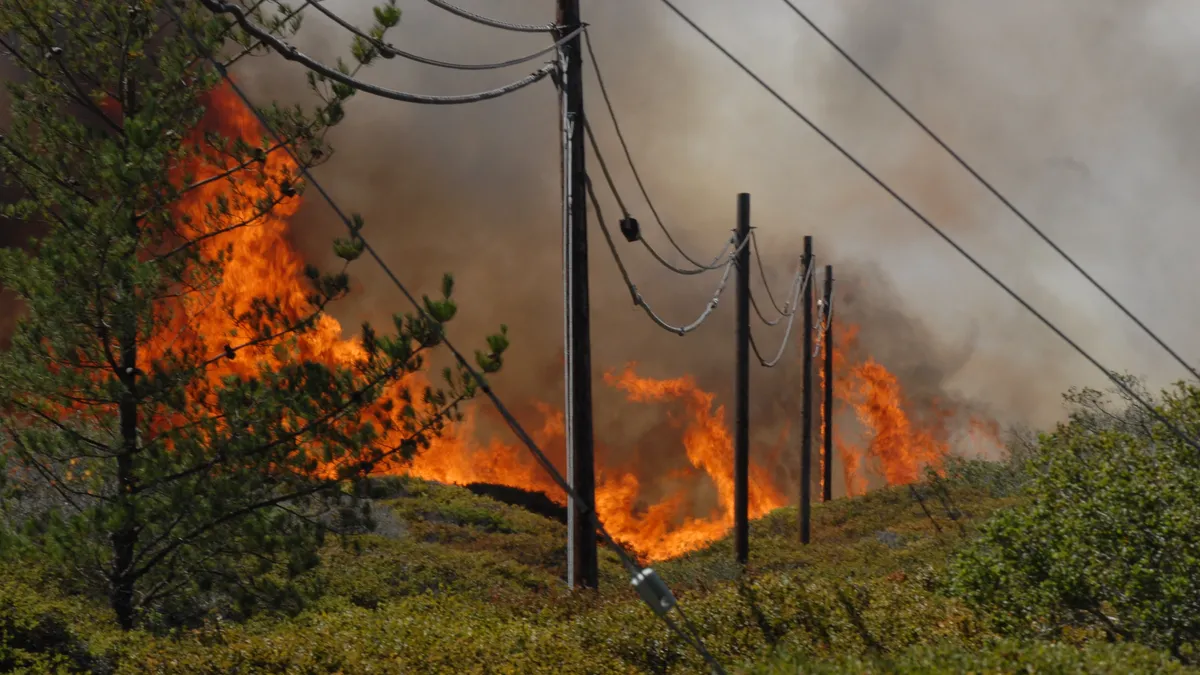Dive Brief:
- The California Public Utilities Commission (CPUC) is considering launching a rulemaking proceeding to examine the practice of proactively de-energizing power lines during high-risk conditions that could spark wildfires.
- The proposed order, which could be voted on during the CPUC's open meeting Thursday, says the commission's proceeding would examine how de-energization has affected the state so far and "refine our approach to the practice to ensure it enhances public safety while minimizing unintended consequences." While the practice has been used sparingly, the state's wildfire conditions are expected to worsen, increasing the potential for de-energization.
- The commission adopted de-energization rules this summer, and Pacific Gas & Electric (PG&E) was forced to cut power to nearly 60,000 people in October during high wind conditions. All California utilities are dealing with wildfire mitigation, but PG&E has been under particular scrutiny over the possibility that its equipment played a role in sparking the deadly Camp Fire blaze.
Dive Insight:
As California's destructive wildfires become the new normal, regulators want to develop precise rules for when utilities use proactive depowering. This can help reduce risk of sparking a fire should a power line go down in high wind conditions, but it takes a toll on communities, the commission acknowledged.
"De-energization can leave communities and essential facilities without power, which brings its own risks and hardships, particularly for vulnerable communities," the commission said in its proposed order.
The proceeding will focus on several critical issues, including:
- conditions in which proactive and planned de-energization is practiced;
- developing best practices and criteria for evaluating de-energization programs;
- ensuring electric utilities coordinate with state and local level first responders;
- mitigating the impact of de-energization on vulnerable populations; and
- examining whether there are ways to reduce the need for de-energization.
PG&E spokesman Paul Doherty told Utility Dive the company supports the commission's review of de-energizing practices, and looks forward to participating.
"We know how much our customers rely on electric service and the impacts that a Public Safety Power Shutoff event can have on our customers, their families and communities," Doherty said in a statement. "We only consider temporarily turning off power in the interest of safety and as a last resort during extreme weather conditions to reduce the risk of wildfire."
The utility also responded to reports that its equipment may have been a cause of the deadly Camp Fire. Doherty said the cause of the Camp Fire "is still under investigation," and "right now, we are focused on assessing infrastructure, restoring power where possible, and helping our customers and communities recover."
He added that the utility is "fully cooperating with any investigations."
PG&E was sued last Thursday by a group of Camp Fire survivors based on allegations that utility transmission towers in Butte County sparked the blaze, due to improper maintenance of "jumper" extensions, the San Francisco Chronicle reported. Cal Fire authorities are investigating the failure of a steel hook connecting a high voltage line to a PG&E transmission tower as the origin of the blaze, according to NBC Bay Area.
California's inverse condemnation rules put utilities in a particularly tough spot when it comes to wildfire damages, as they can be held liable even if there was no negligence. Legislation is in the works to bring some financial security to utilities, as state regulators have made clear they do not want PG&E forced into bankruptcy.
One proposal would extend provisions of previous wildfire liability legislation, passed this fall to address 2017 fires, to include fires this year.














